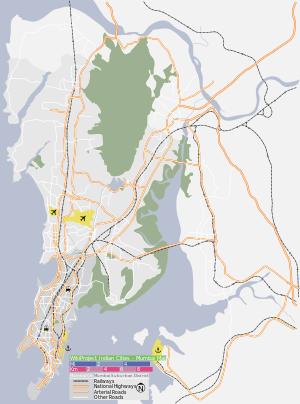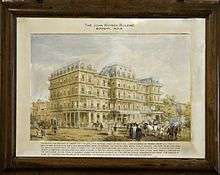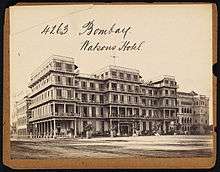Watson's Hotel
| Watson's Hotel | |
|---|---|
 Watson's hotel, now known as Esplanade Mansions at Kala Ghoda | |
 Location within Mumbai | |
| General information | |
| Town or city | Mumbai |
| Country | India |
| Coordinates | 18°55′42″N 72°49′52″E / 18.9283°N 72.8311°E |
| Construction started | 1867 |
| Completed | 1869 |
| Client | John Watson |
| Technical details | |
| Structural system | Cast iron |
| Design and construction | |
| Architect | Rowland Mason Ordish |
| Engineer | Rowland Mason Ordish |
Watson's Hotel (actually Watson's Esplanade Hotel), now known as the Esplanade Mansion, is India's oldest surviving cast iron building.[1] It is located in the Kala Ghoda area of Mumbai (Bombay). Named after its original owner, John Watson, the building was fabricated in England and constructed on site between 1860 and 1863.
The hotel was leased on 26 August 1867 for the terms of 999 years at yearly rent of Rupees 92 and 12 annas to Abdul Haq. It was closed in the 1960s and was later subdivided and partitioned into smaller cubicles that were let out on rent as homes and offices. Neglect of the building has resulted in decay and, despite its listing as a Grade II–A heritage structure, the building is now in a dilapidated state.
Design

Watson's hotel was designed by the civil engineer Rowland Mason Ordish, who was also associated with the St Pancras Station in London. The building was fabricated in England from cast iron components and was assembled and constructed on site. The external cast-iron frame closely resembles other high-profile 19th century buildings such as London's Crystal Palace. The main façade of the hotel is distinguished by building wide open balconies on each floor that connected the guest rooms, which were built around the atrium in a courtyard arrangement.[2]
History

John Hudson Watson was born in 1818 in Castle Carrock, England to a farming family. He ran a successful drapery business in Bombay. His original plan for the building was to use it as additional office and showroom for his thriving drapery and tailoring businesses nearby.[3] started to begin to ship pre-fabricated cast iron components from England as early as October 1865. The hotel was built between 1867 and 1869. The original design, as displayed on the painting in the Watson Institute, included plans for traditional European mansard roof, however it was never built.
John Watson opened the hotel as an exclusive whites-only hotel, and it one of the most renowned hotels in the city in those days. Then it was handed over to Hannah Maria Watson, by then the Secretary of State for India, wherein she entered into a lease deed with Sardar Abdul Haq,Diler ul Mulk,Diler ul Daula, for a term of nine hundred and ninety nine years on 26 August 1867. Later on, another indenture was made on the date 22-12-1885, between the trustees of Port Trust of Bombay and Sardar Diler ul Mulk in which land on the Wellington Reclamation Estate in island of Bombay admeasurment of 8129 sq.yrds. was leased by the Sardar Abdul Haq for a term of fifty years from 01-01-1880. The five-storied structure housed 130 guest rooms, as well as a lobby, restaurant and a bar at the ground level. The hotel also had a 30 by 9 metres (98 ft × 30 ft) atrium, originally used as a ballroom, with a glass skylight. At its peak, Watson's hotel employed English waitresses in its restaurant and ballroom, inspiring a common joke at the time: "If only Watson had imported the English weather as well."[2][4]
By 1920, Watson’s ceased to be a hotel and had been renamed Mahendra Mansion. It 1944, it was renamed Esplanade Mansion. In 1960 it was converted into housing and offices accommodating.
After Watson's death, the hotel lost its popularity to the rival Taj Hotel. In the 1960s the hotel was closed. Sometime after this, it was subdivided and partitioned into small cubicles with independent access and let out on rent. Over the years, apathy toward the building by the residents has resulted the building decaying, and it is now in a dilapidated state. The atrium was subsequently used as a dumping ground and has several illegal constructions. As of 2005, building had 53 families and 97 commercial establishments. Most of the commercial establishments are chambers of lawyers attached to the adjacent Bombay Civil & Session Courts and the nearby Bombay High Court.[2][4]
Sadik Ali, current owner of Esplanade Mansion, came to be the proprietor in early 80s after the building's then owners, the Tatas, sold it to him.[5] He plans to redevelop the building in partnership with the tenants (it is virtually impossible for long term tenants to be removed in India).
Notable guests
_with_Rajabhai_Clock_Tower_in_the_background%2C_Mumbai.jpg)
Among the hotel's notable guests was Mark Twain, who wrote about the city's crows he saw outside his balcony in Following the Equator.[6] It was also the first place in India to screen the Lumière Brothers' Cinematographe invention in 1896.
Muhammad Ali Jinnah used to play pool in the hotel, to make a little extra money for himself.[7]
A popular myth surround the hotel was that the staff at Watson's Hotel denied Indian industrialist Jamsetji Tata access to the hotel. In retaliation he built the Taj Hotel, a hotel that stands near the Gateway of India, in 1903.[2][4] However, author and historian Sharada Dwivedi disputes this legend, on the basis of a lack of evidence to prove that "Tata was a man of vengeance".[8]
Current state
The building's poor state of affairs has been commonly remarked, and efforts by heritage activists to persuade its present owner to invest in restoration have been unsuccessful. One of the possible reasons proffered for apathy is the fact that the rent collected is low as it has been frozen by government legislation.[1] The condition of the building was publicized by Italian architect Renzo Piano, and as a result of his efforts, the building was listed in June 2005 on the list of "100 World Endangered Monuments" by the World Monuments Fund, a New York-based NGO.[9] Just a few days after its nomination, part of the building's western façade, originally balconies developed into small offices, collapsed, killing one person and crushing several cars and motorcycles parked in the street below. The building is listed as a Grade II–A heritage structure.[2][4] On 13 June 2010, the Mumbai Heritage Conservation Committee (MHCC) gave its approval for the 130-year-old structure to be restored. The restoration work will be carried out by the Maharashtra Housing and Area Development Authority (MHADA).[10]
Also see
- Esplanade House, Jamsetji Tata's residence 1885-87
- Cast-iron architecture
- United States Capitol dome constructed using Cast iron
References
- 1 2 Choudhury, Chitrangada (2005-06-24). "Now listed as 'endangered', Watson's Hotel was once toast of Bombay". Indian Express. Express Group. Retrieved 2008-12-29.
- 1 2 3 4 5 "India's 'cast iron' bldg crumble". Mumbai Mirror. Times Group. 2005-07-02.
- ↑ Why Is This Painting Of Watson’s Esplanade Hotel, In Mumbai (Bombay), Hanging In The Watson Institute? Tom Speight, Chair of the Watson Institute, September 2013
- 1 2 3 4 "Watson! You are a forgotten soul". Times of India. Times Group. 2005-06-23. Retrieved 2008-09-27.
- ↑ Rs. 450 crore heritage mansion up for redevelopment, Mid-Day.com, July 04, 2013
- ↑ Twain, Mark (1897). "The Indian Crow". Following the Equator — A journey around the world. American Publishing Co., Hartford. p. 355.
- ↑ http://archive.indianexpress.com/news/jaswant-in--jinnah-s-bombay--jinnah-house-belongs-to-daughter/525912/0
- ↑ Choksi, Mansi (2008-12-16). "Unbreakable: An Enduring Symbol Of Mumbai's Culture, Heritage And Global Status Turns 105 Today". Times of India. Times Group.
- ↑ Joshi, Monika (2005-06-21). "Mumbai's Watson's Hotel in endangered structures list". Rediff.com. Retrieved 2008-09-27.
- ↑ Jain, Bhavika (2010-06-13). "MHADA to restore Esplanade Mansion". Hindustan Times. Mumbai.
| Wikimedia Commons has media related to Watson's Hotel. |